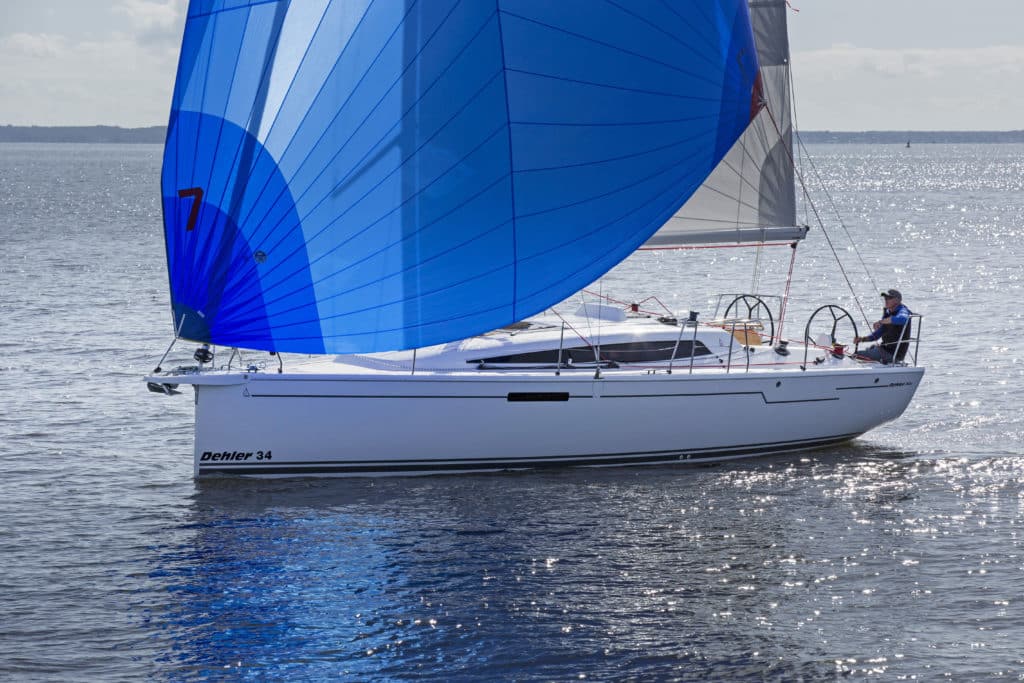
The 2017 Boat of the Year (BOTY) contest featured a stellar crop of crossover cruiser/racers, including new offerings from J/Boats and Elan, two firms well-known for their speedy, well-sailing craft. However, when all the testing was said and done, our independent panel of judges was sold on the Dehler 34, naming it the year’s Best Performance Cruiser. Designed by the highly regarded Judel/Vrolijk naval-architecture consortium, whose reputation was fostered by longtime success in international yacht-racing circles, the 34-footer combined contemporary good looks and a sweet turn of speed with better-than-average comfort and accommodations below. It didn’t hurt that the boat, nicely equipped at $215,000, was the least-expensive entry in the entire 2017 fleet. All in all, it proved to be a winning formula.
With a gentle, sloping sheer line, plumb bow and max waterline, the 34’s no-nonsense profile is both handsome and purposeful. Starting aft and working forward, the drop-down transom is easily accessed through the split, adjustable backstay, which is controlled by a simple block and tackle. A traveler is just forward of the twin wheels, each of which are affixed to Jefa steering pedestals. A pair of B&G chart plotters is stationed just ahead of the helms in molded-in fixtures with rounded corners that double as nice backrests for the long cockpit settees — it’s very clever. There’s a nice cockpit table that can be easily removed when club racing.
There are three sets of Lewmar winches: a pair within easy reach of the driver for the double-ended German mainsheet system, another set just forward of those that serve as primaries for the 108 percent headsail, and a third pair on the coachroof that team with Spinlock clutches to control halyards and reefing lines. A nifty arrangement of integral companionway slats folds directly into the companionway when not in use.
The molded toe rail is capped by a substantial bulwark for solid footing on a heel; moving about easily underway is also facilitated by outboard shrouds and chain plates that keep the teak side decks clean and clear. The swept-back double-spreader fractional rig is by Seldén, as is the solid Rodkicker vang. The standing rigging is rod. A Furlex roller-furling unit is mounted on the bow, ahead of which is a dedicated bowsprit with a single anchor roller and a pad eye on the outboard end for setting reaching and running sails.
Down below, there are double cabins in the ends of the boat (a V-berth forward and standard double aft). A pair of long settees sandwich a folding dining table in the main cabin; to port, a corner of the settee serves as the seat for the aft-facing nav station. At the foot of the companionway, a big head with shower is also to port, while the L-shaped galley is situated just across from it, to starboard. Two big overhead deck hatches provide good ventilation, as do the opening ports in the coachroof windows.
Construction is straightforward: A central carbon “cage,” or grid, anchors and distributes the loads between the mast, hull and keel. The hand-laid laminate employs an end-grain balsa core above the waterline and in the deck. A performance package that makes the boat a true racer — featuring a competition keel and rudder, a carbon rig, high-performance sails and a different winch package — is also available.
We sailed the boat on Chesapeake Bay in light airs that didn’t top 5 knots, but the boat was still a delight to steer, especially downwind with a big asymmetric kite, making nearly 4 knots in what was basically a zephyr. We could only imagine how she’d get up and go in a breeze.
Herb McCormick is CW’s executive editor.








